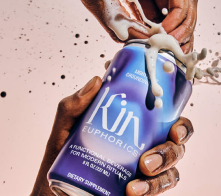
It’s reported up to 75 percent of email subscribers are inactive. If you've been doing email marketing for a while, you probably feel this pain point. We're guessing you have a list of unengaged emails you've had to prune over time and can no longer safely email them...right?
As you already know, those inactive users will only hurt your engagement metrics and also impact your deliverability reputation if you keep sending to them.
However, thanks to our Reactivate feature, you can now safely email and re-engage those subscribers. But what should you be sending them?
What are re-engagement emails?
A re-engagement campaign — also known as a win-back email — is a single or sequence of automated emails sent to inactive subscribers with the goal of getting them to interact with your emails again.
Even if you’re unfamiliar with the term, you’ve seen them in your inbox. They’re the emails with subject lines like, “We miss you,” or “We want you back.” And they work.
Studies have shown that nearly half of subscribers who receive re-engagement emails will read subsequent emails. But to experience these (or better) stats, you need to ensure your re-engagement campaign catches their attention. And to do that, you need to make sure you’re sending the right messaging in the right order.
Examples of re-engagement email series
Before you start creating some must-open emails for your re-engagement campaign, you’ll need to figure out how many you need and what each should say. To do that, you should map out your automation journey.
Here’s an example of an automation series you could use for your re-engagement campaign:
- After 30 to 90 days with no engagement, contacts are placed in the inactive segment.
- Send a “We Miss You” email — something short and sweet.
- Wait a certain number of days (ex. two weeks).
- Send a follow up “We Miss You” email.
- Wait a certain number of days again.
- Let them know this is their last chance to engage with your brand before they are removed from your list.
- If there’s still no activity with the customer, move them to a new segment to be removed from your list.
To get a better idea of what a re-engagement email series looks like, here's an example of one from Animoto.
Opener
Subject line: Get the most out of Animoto, all year long
The opening email focuses on providing value to the user, telling the reader Animoto will help them get the most of out their services. The email then uses an eye-catching infographic to give them ideas for their next project. This example gives the user a reason to come back instead of simply pushing them to engage, and that's what you want with your first email in the series.

Middle
Subject line: Did you miss out on some of these new features?
In another email example from Animoto, this message focuses on telling the reader what they have missed out on since they stopped engaging — a little stronger approach than the first one with "Been a while?" It shares new features, capabilities, and a “Learn More” CTA that shows them even more updates.

Ending
Subject line: Did you still want to hear from us?
This email is a more to the point about why the reader is receiving it. The brand is trying to find out if the reader still wants to subscribe to their emails. The email gives the subscriber the option to update their email preferences so they receive messages on topics they enjoy. It also tells them how to unsubscribe from the email, saving you the step of removing them if they no longer want to engage.
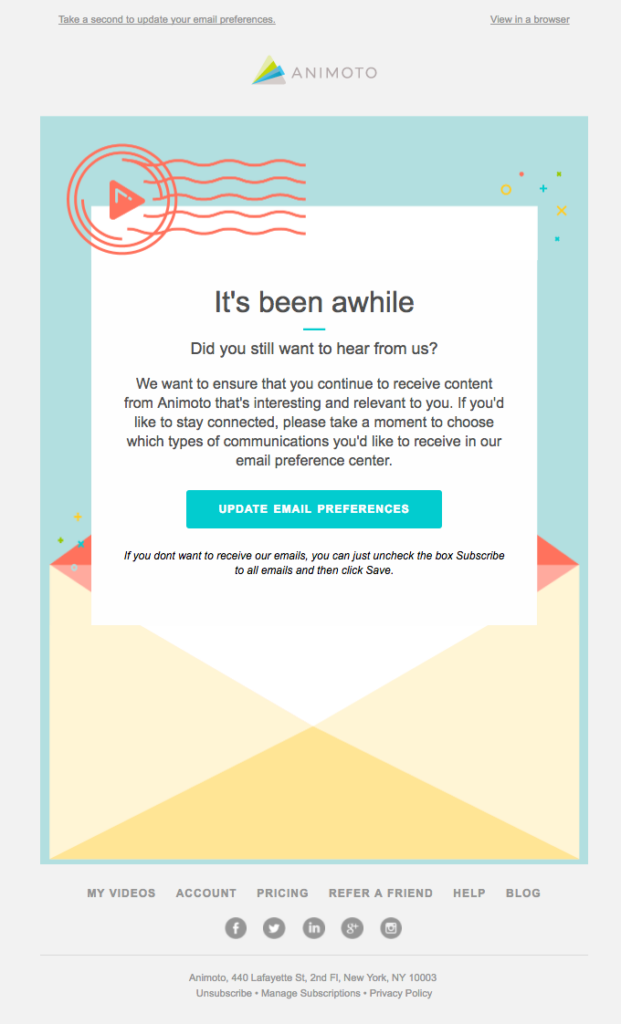
You could even follow up from this one saying that this is the last communication the subscriber will receive from you if they don't take action — update their preferences, engage with the CTA, sign in, etc.
Single Email Example
Not every re-engagement campaign has to include several emails in the series. Here's one email that covers it all within a single email.
Subject line: Your HubSpot account will be deactivated in 30 days
This email from HubSpot gets straight to the point: If the user doesn't sign into their account within the next 30 days, their account will be deactivated. The message reminds them what type of account they signed up for and that HubSpot deactivates any account that has 120 days of inactivity.
HubSpot also includes a link to a guide that can help them get started back, in case maybe there was a question or hurdle to engaging that it could address.
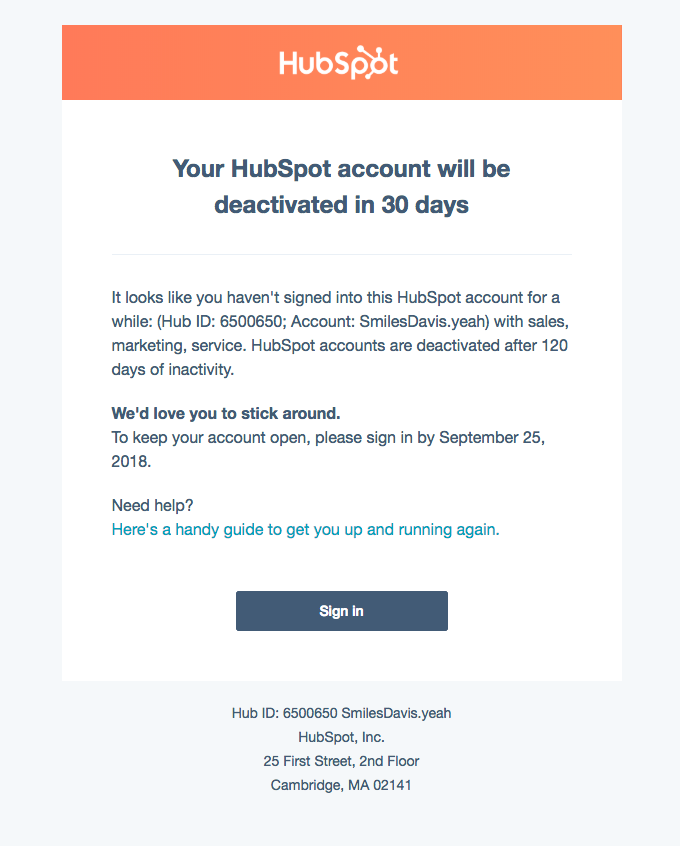
While it can sound harsh to remove contacts — especially when you want to grow your lists — they are only hurting your metrics and reputation.
Now that we’ve covered the basics, it’s time to jump into real examples of emails that are sure to engage your wayward contacts once again. We’ve broken re-engagement email examples down for publishers, e-commerce, apps and technology, and events — but you can use ideas and techniques from any of them for your next campaign.
E-commerce Emails
From personalization to incentives, these e-commerce re-engagement emails offer audiences a little bit of everything to bring them back.
Teespring
Subject line: You got this.
Again with the puppy eyes. Teespring is targeting e-commerce brands with this email, which is why it landed here. Something this email does well is providing a truly personalized experience by inputting specific stats from their account.
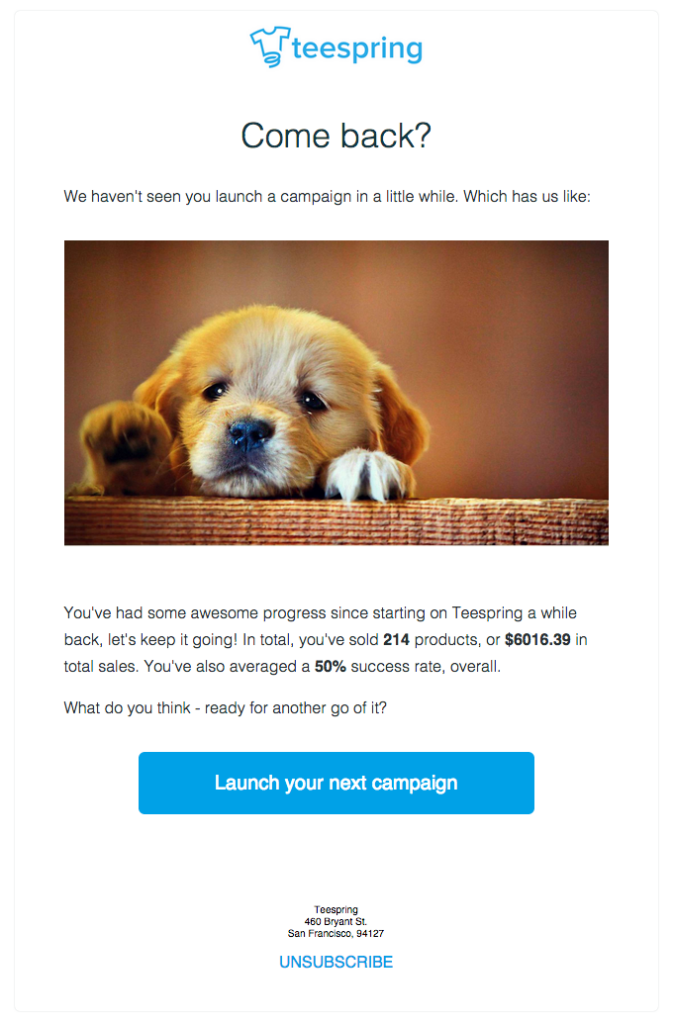
Urban Outfitters
Subject line: Are we seriously breaking up?
Urban Outfitters proves it knows its audience with this re-engagement email. Removing an inactive customer from your list does kind of feel like a breakup, so this campaign's message is right on point. The CTAs are pretty fun too.

1-800Flowers.com
Subject line: Just Remember… We Just Love Treating You: Shop Our Sale & Get 20% off Everything!
What better way to woo a contact back to your brand than with a deal? 1-800Flowers.com offers the customer a 20-percent off sitewide coupon and shows them an example of a beautiful arrangement they could use that coupon on.

Yoox
Subject line: There's still time!
Maybe 20 percent off is the magic number because Yoox also offers customers that discount if they make a purchase — along with free shipping. They also include a deadline to use the code, which is smart because of the customer doesn't click the link right then, chances are they won't.
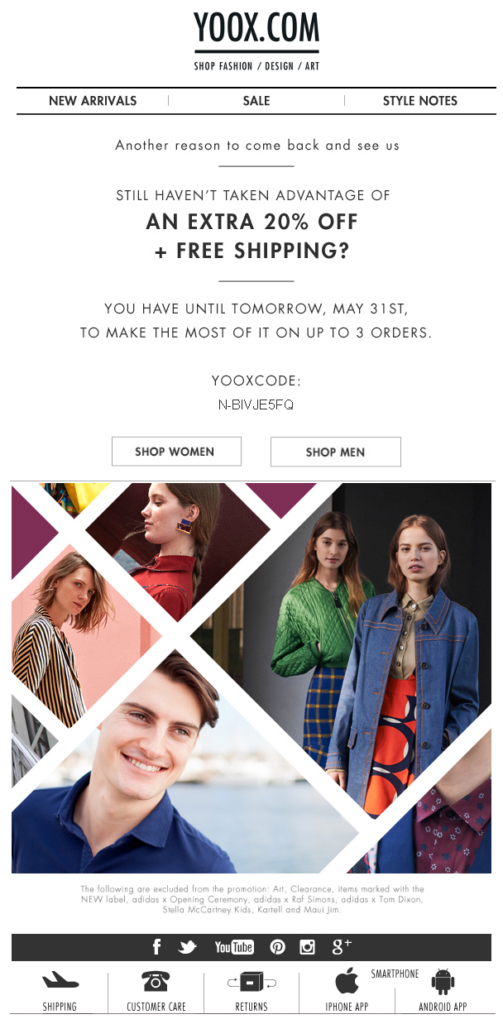
Birchbox
Subject line: Lucky you! There’s still time to claim your prize
Instead of telling customers they want them to come back, Birchbox gives them a reason to return with this email. They offer their subscribers a free prize when they make their first purchase, using the fun “Let’s Play” CTA — and an image every girl can relate to from her middle school years. We like this different approach that varies from the typical, “We miss you,” messaging. It shows you how to combine both an offer and re-engagement message all in one.
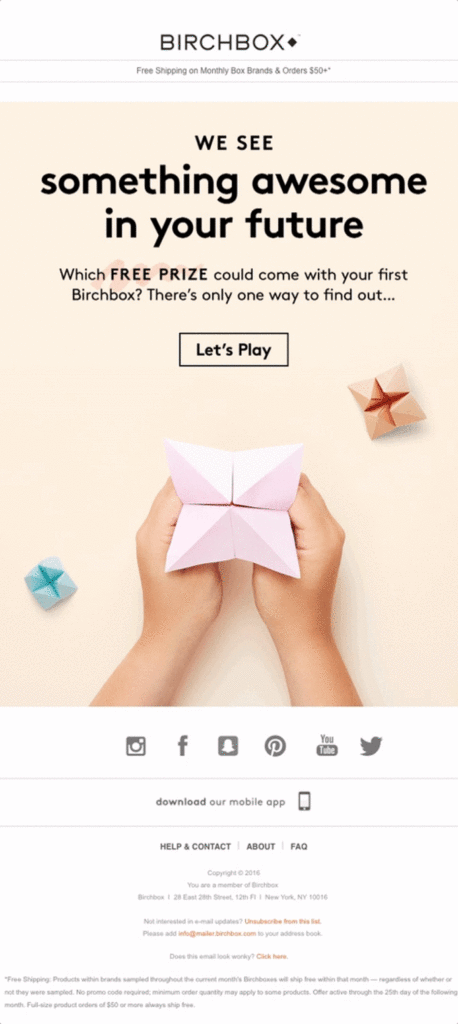
Paul Mitchell
How about a re-engagement campaign that also combines your products? That's what Paul Mitchell did with this, "We hate goodbyes," email — using the products to create a sad face. At the bottom, there's a clear CTA to stay subscribed.
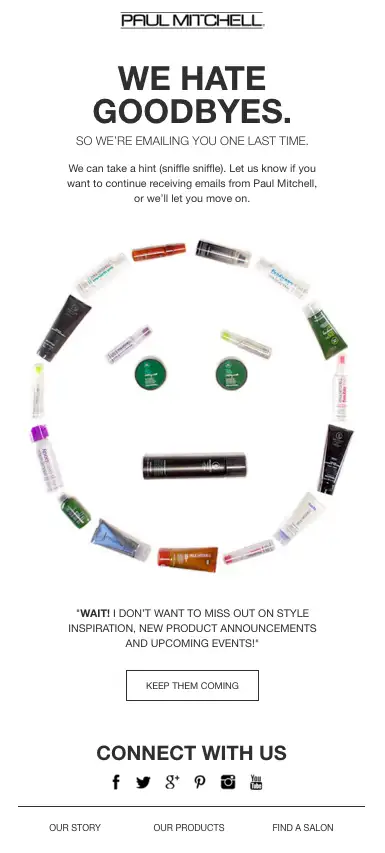
Framebridge
Subject line: Goodbyes are hard...
At the end of your re-engagement email campaign series, it’s time to cut to the chase like in this email from Framebridge: If they don’t engage with your email, this will be the last they hear from you. That sounds so final, right? Well, that’s the point. You want to make it clear that you don’t want to waste their time if they don’t want to receive your messages anymore. But if they do, they can simply click the CTA, “Wait, keep me on the list,” to stay connected.
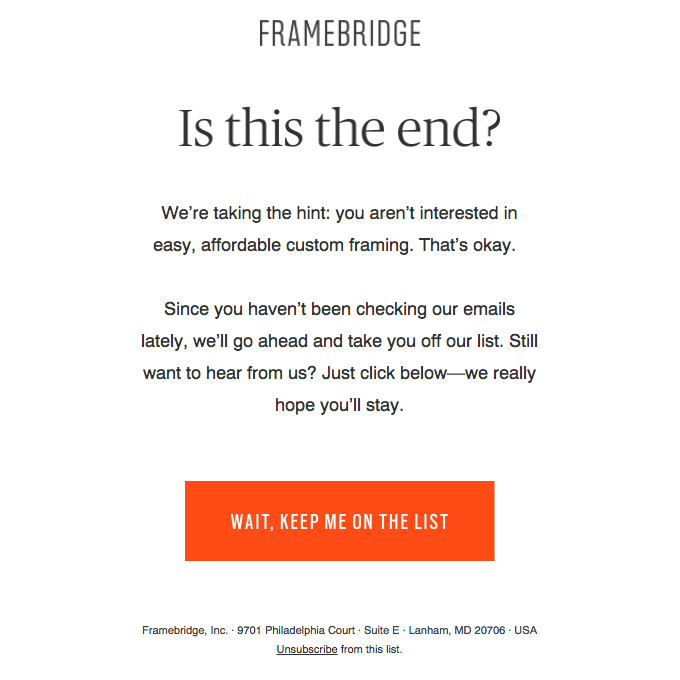
Lowe's
Subject line: We've made some improvement since you've been away
This email from Lowe's gives subscribers a step-by-step list of what's new with the brand since they last engaged. This gives the customer a variety of features and news to check out, so there's bound to be something that catches their interest.
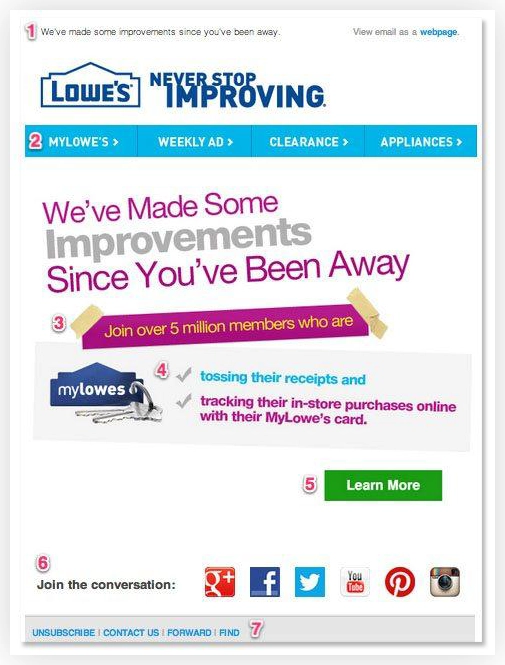
Publisher Emails
The user has engaged with your publication in the past, but for whatever reason, they stopped and never signed up — or let their subscription lapse. Here are examples from publishers that show how to re-engage those customers.
Digiday
Subject line: What you’ve been missing from Digiday
Valuable content is the main selling point for publishers, so why not remind your audience about the amazing stuff you’ve been sharing since they’ve been gone? In this email from Digiday, they include a rundown of the recent edition to give the reader a glimpse at the information and topics they missed out on. We also like how they include Digiday in the subject line so there’s no doubt who it’s from and what it’s about. (This is a shortened version of the email.)
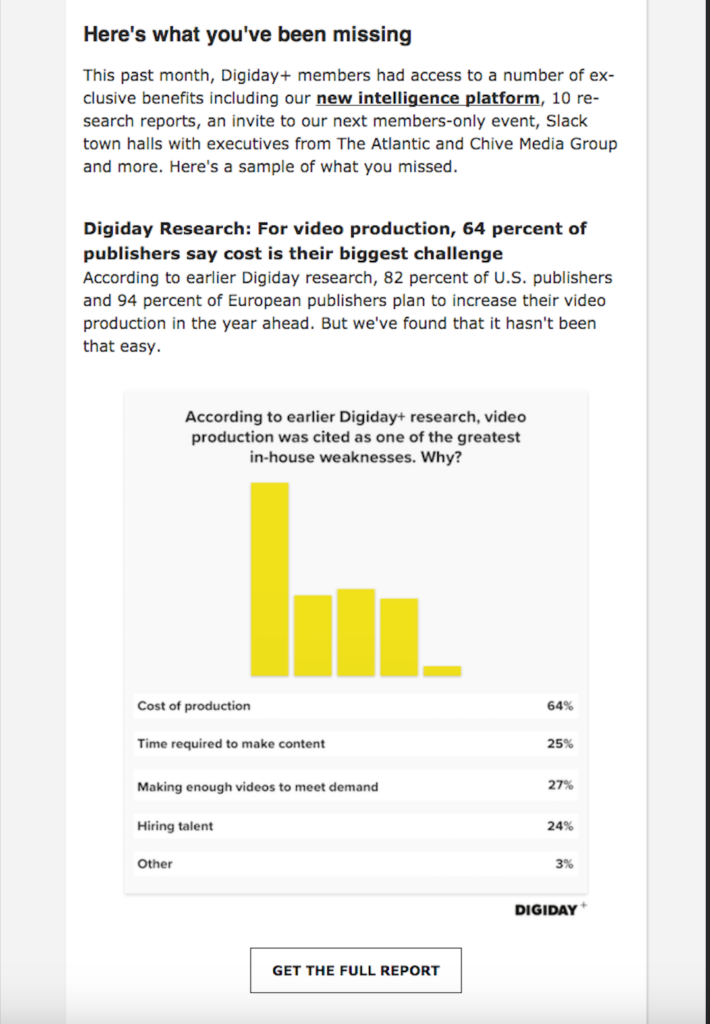
The New Yorker
Subject line: Get a deeper look into right now
An email like this one from The New Yorker reminds them what they’re missing (i.e. “outstanding long-form journalism”) and also includes the cost and perks to signing up. Being specific and upfront about the costs is a good idea because it doesn’t bury the lede, as these writers might say.
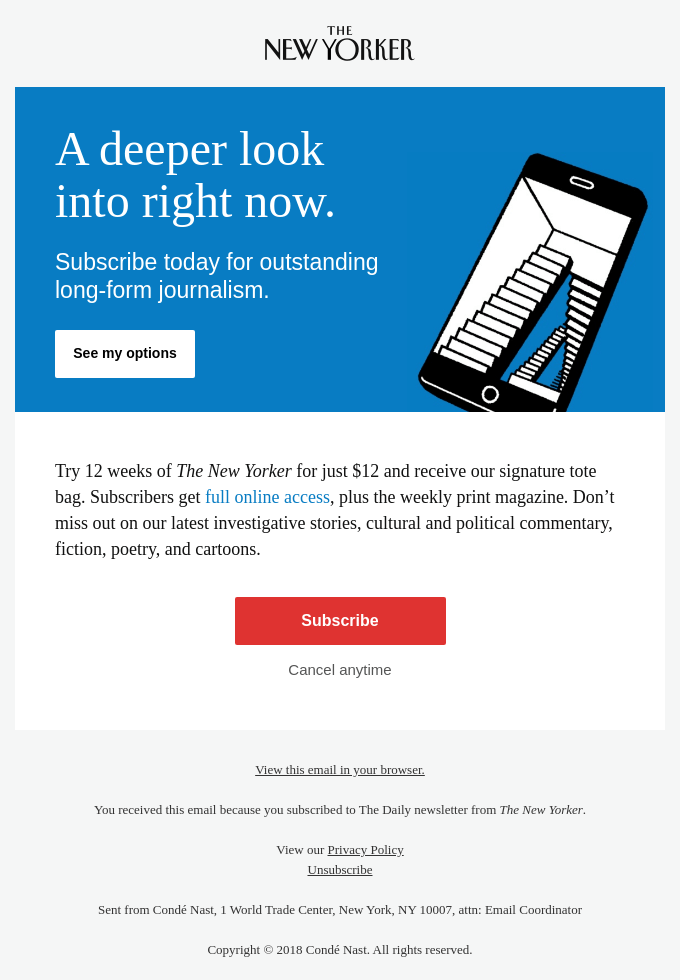
Event Emails
Whether your event has passed or is about to come up, you want to let your audience know — and that includes the inactive members, as well. An event can be a great way to catch their attention, like brands did in these examples.
Campaign Monitor
Subject line: Marketing & Mixology was a hit.
No one wants to feel like they missed out on something great — which is exactly what Campaign Monitor is counting on with this re-engagement email. Following their event, they sent this email to no-shows to give them a glimpse at what they missed out on. That does two things: It gives them valuable information via event highlights (engaging them), and the email also shows them they shouldn’t miss out on future events.
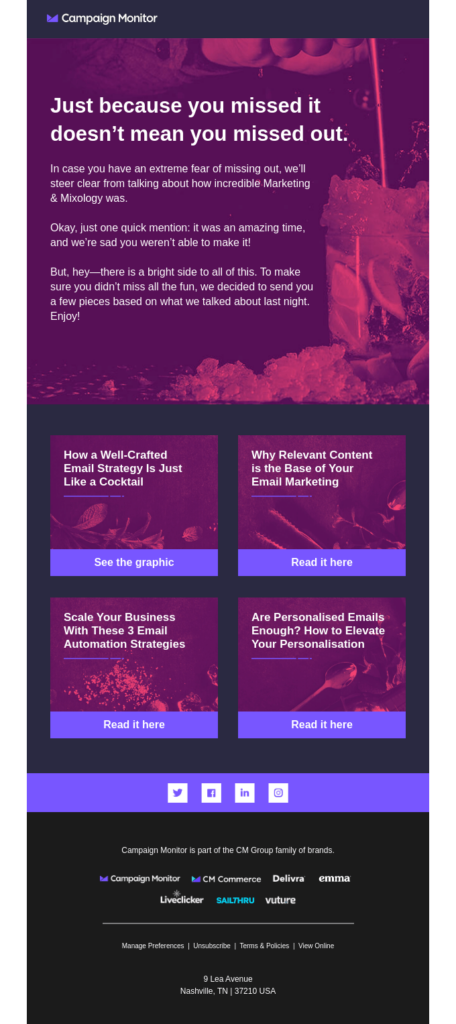
Tough Mudder
For customers who have yet to sign up for the five-year celebration event, Tough Mudder is there to tell them why they should — and why they should sign up ASAP. They offer them a 25-percent off coupon and included a video of someone who had participated. Above the "Find My Event" CTA, they remind customers some events may be sold out, which only increases their FOMO (that's a good thing).
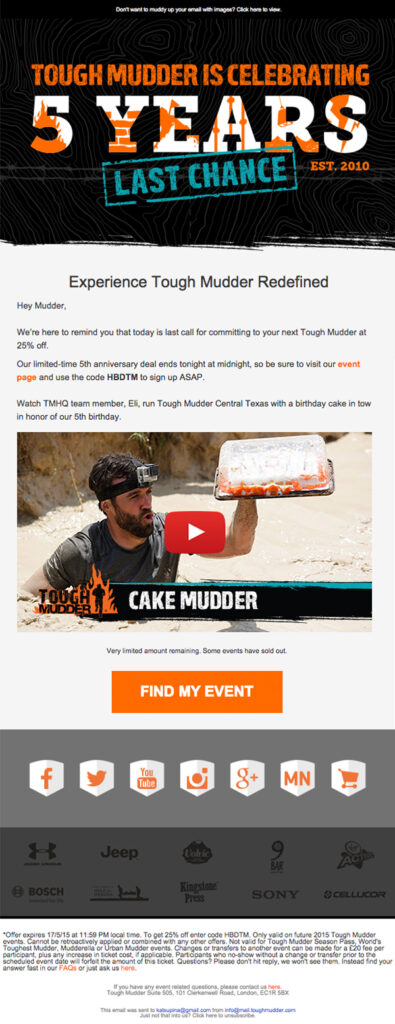
Cotton Works
Subject line: See you in Denver next month? ⛰
Not all event re-engagement emails need to come after they’ve missed the event, as you’ll see with this one from Cotton Works. The email reminds them of an upcoming event and gives them the details about when and where to find them. Emails like this are especially effective when you’re able to use a local segment because that makes it more personalized.

App and Technology Emails
Have users stopped interacting with your platform and/or emails? See if you can bring them back in with re-engagement emails like these examples.
Uber
Subject line: Did you know we’ve made big changes in the last year?
Instead of making the subscriber feel bad about not engaging with your platform, why not try the approach that Uber used? They praise the user right off the bat in this email, “[Name], it’s so nice to see you again.” From there, they detail some of the things the user might have missed since they last interacted with the company — highlighting updates, news, and improvements.
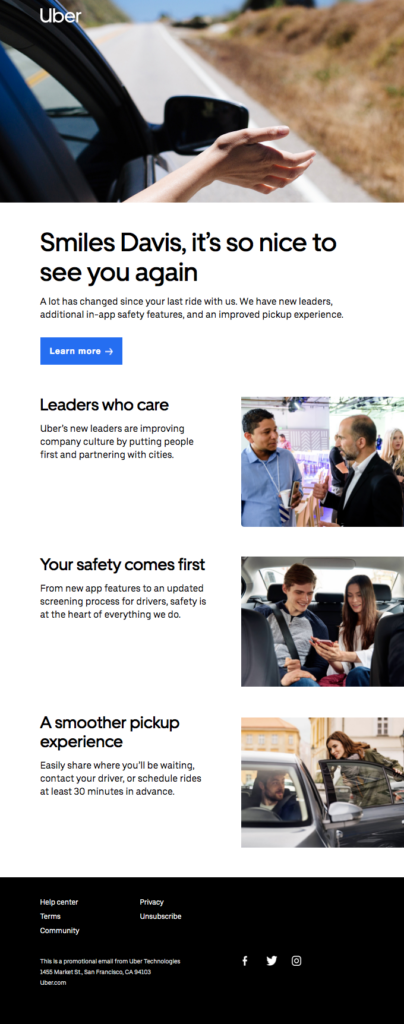
Duolingo
Subject line: We miss you
From the subject line to header text, “We haven’t seen you in a while,” this re-engagement email from Duolingo makes it clear why the contact is receiving the email. Again, the message is two short sentences, first posing a question and then telling the user how to take action. The CTA is a little on the lengthy side, but it is customized for the brand, which is a plus.
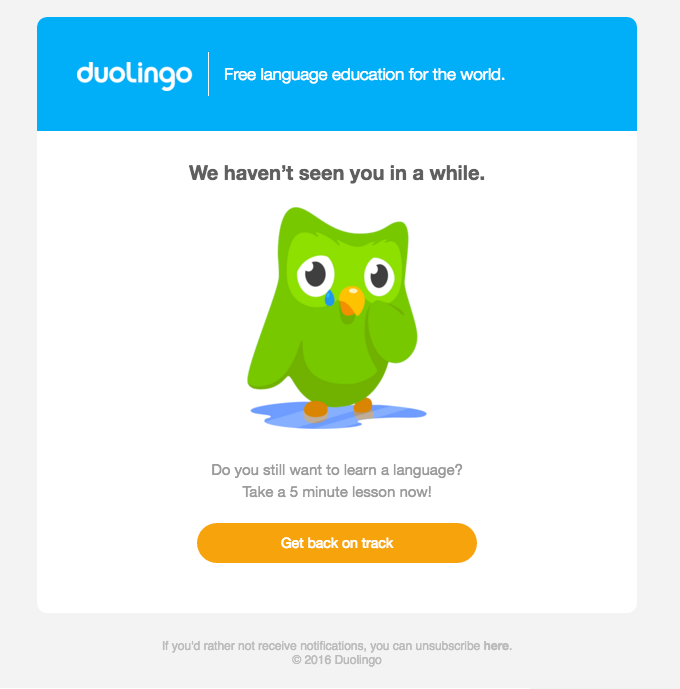
Busuu
Subject line: [Name], we’ve not seen you in a while
Another language app, Busuu throws in an emoji in the subject line to get across how sad they are that the user hasn’t engaged with them recently. The email serves as a reminder to stick with what they started, using the CTA, “Give it another go.” The message provides encouragement and (hopefully) the push they need to re-engage.
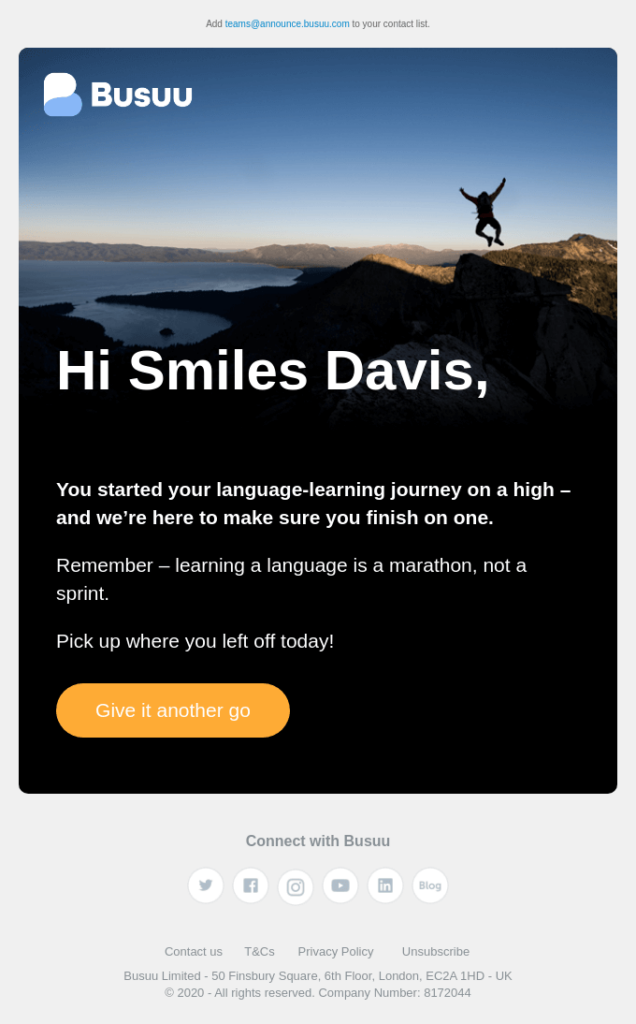
Resy
Subject line: It’s been a while
The subject line from this Resy email is also carried over as the header of the message, followed by a series of CTAs. Giving multiple CTAs can sometimes overwhelm the user, but these are clearly defined and used as part of the overall design. One thing the brand could have done better is provide some context for what the company is all about. Resy connects users to restaurants, but you wouldn’t get that from the email. And if they haven’t interacted with you in a while, they might need that reminder.
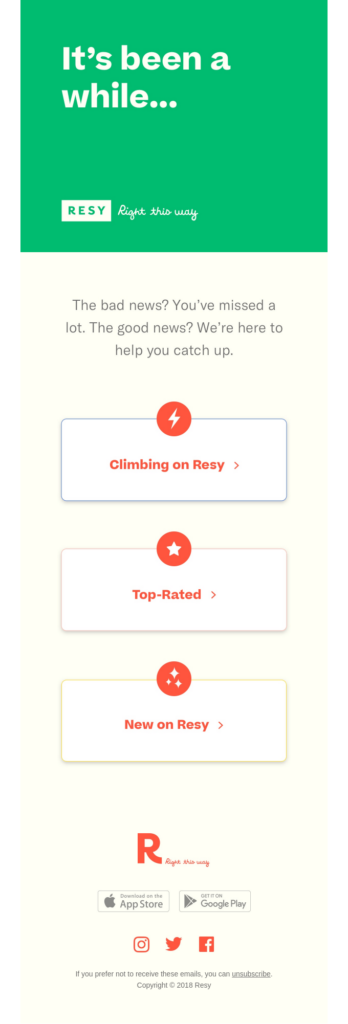
Udemy
Subject line: Hey [Name], take action to let us know if you still want to get emails from us
The branding and messaging couldn’t be clearer in this re-engagement email from Udemy. They also tell them why they should engage and offer them an incentive to do just that. While we are all about being informative with subject lines, this one might take it a bit far, considering the majority will be cut off for the user on both mobile and desktop devices.
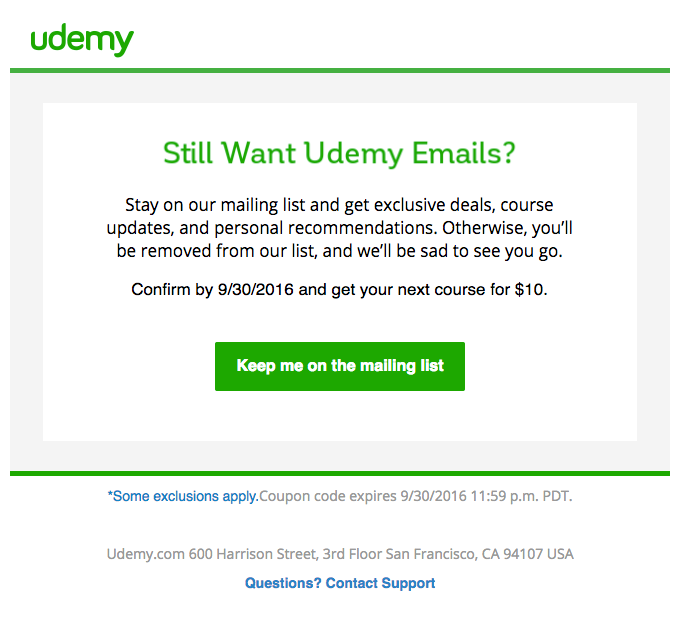
Grammarly
Subject line: You’ve earned a new badge!
Who doesn’t like being recognized for something they’ve done? Grammarly is banking on the answer to that being “no one” with this email. Wanting to see what badge they earned, users might be surprised to see it’s one for not using the program — pretty clever, huh? Basically, the platform is letting the user know they ghosted Grammarly, and they want them back. They use a fun CTA that fits the branding and messaging, as well.
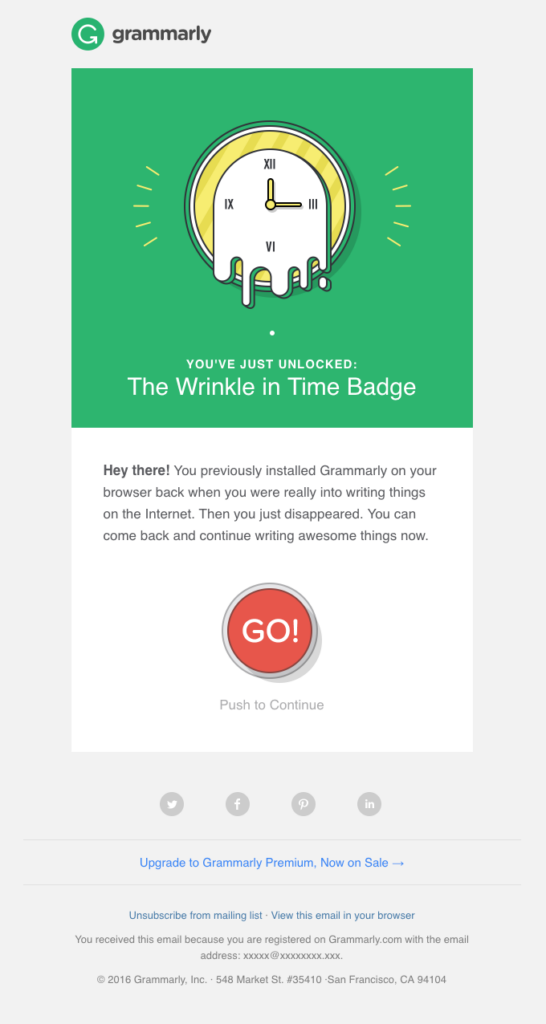
Kickstarter
Subject line: The power of updates
Been a while since your user has engaged? It’s time to not only check in, but to also give them valuable, actionable information like this email from Kickstarter — because your emails shouldn’t just be self-serving. Yes, you want them to engage, but at the end of the day, if what you’re sending doesn’t benefit your subscriber, you’re wasting your time.
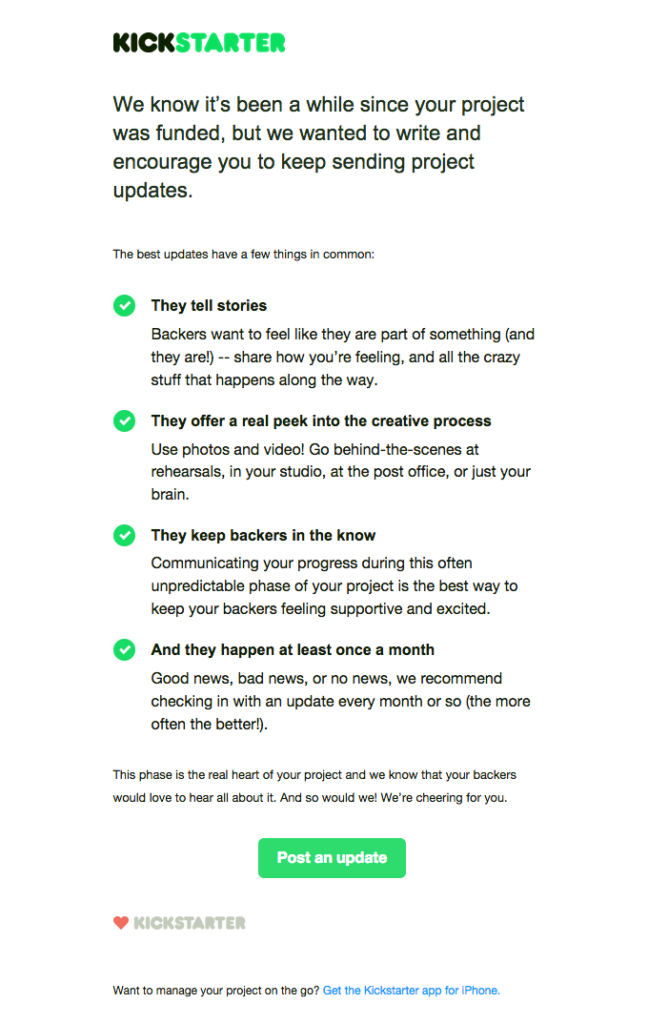
Google Maps
Subject line: We miss you on Google Maps
Nothing portrays sadness as well as puppy eyes, and this email has that image covered. Google Maps keeps the message short and to the point, which is exactly what you want your email to be like. The CTA is customized to what they want the user to do — “Contribute Now” — driving home the re-engagement effort.
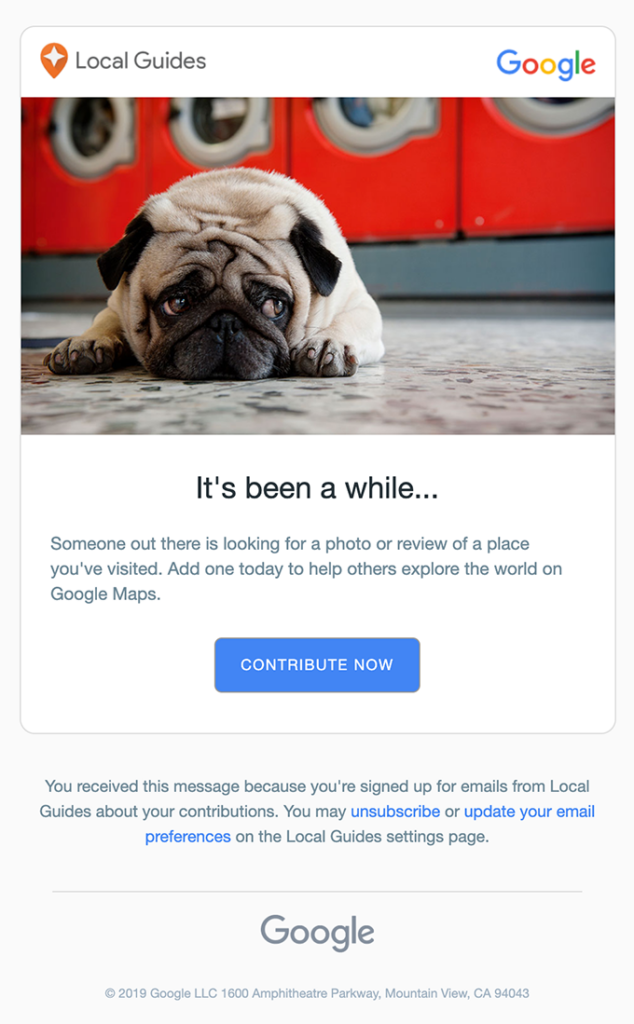
Skillshare
Subject line: Come see what’s new!
Instead of using the “We’ve missed you,” line as the subject line, Skillshare puts it in the header of the email — and uses something more positive for the subject line about what’s new. They show and tell the user what’s new since they last interacted, and they also offer them an incentive to come back — a winning combination.
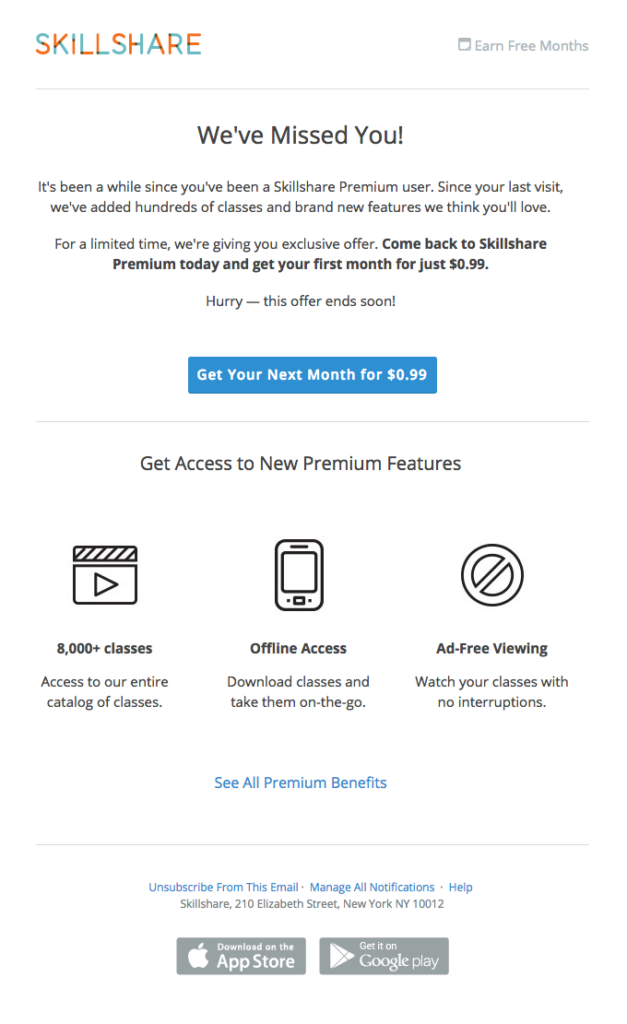
Ready to re-engage?
Before you hit send on a stellar re-engagement email campaign, make sure you segment your inactive audience members and have your automation schedule set up. Whether you send them updates, offers, or a “We miss you,” message, be sure it’s clear you want them to come back!
